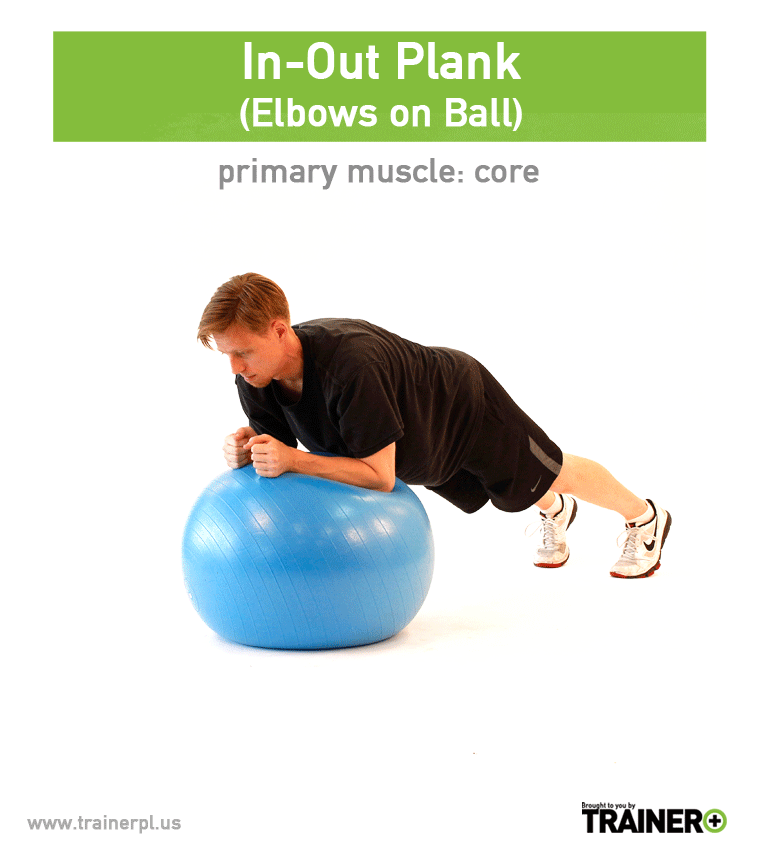UNSTABLE DYNAMIC PLANKS ON EXERCISE BALL
primary muscle: core
supporting muscles: abs, low back, hips
The plank or front hold is the most important exercise for your core as it engages all of the core muscles to build both strength and stability through your whole body. Keeping a straight line between ankles, knees, hips and shoulders promotes the type of stable strength used through those joints, and more importantly, your torso, in everyday movements like sitting, standing, walking, etc. This exercise not only makes all of the muscles in your torso have to work to maintain the alignment (abs, low back, oblique, transverse abdominus), but also involves the shoulder and hip girdle to bare the weight, the other key body parts that make up the core. Adding movement or dynamicism makes all of the muscles involved have to work harder to maintain body alignment as the load shifts throughout the movement, helping increase functional strength/stability. Adding further instability into the exercise with the exercise ball makes the muscles that work to stabilize the hips and shoulders, in addition to torso, have to be more engaged to help balance and keep alignment, promoting balance and stable strength. This is an increased challenge with the ball as it has a surface that will shift in 360 degrees of space and the inflated surface is inconsistent to balance against.
These exercises come from our exercise library at Trainer+, a web and mobile platform for personal trainers.
Are you digitally tracking every set and rep that your clients do with or without you?
In & Out Plank on Elbows
The 'easiest' of the dynamic exercise ball planks with 4 points of contact to balance, this variation puts a focus on the upper body stability by placing the ball under the elbows, meaning the scapula (shoulder blades) are working to stabilize and maintain body alignment throughout the movement. By rolling the ball in and out, the shoulders have to work extra hard as the arm angle changes, and along with the other core muscles, to maintain body alignment as the centre of gravity changes lengthwise and the core, particularly the abs, are extended (similar to an ab wheel). This exercise can be made more difficult by placing feet on a bench and getting body parallel to the ground.
Knee Tucks
Placing the ball under the feet makes the hips, knees and ankles have to work harder to maintain body alignment and balance from side to side, while rolling it in and out makes those same joints work extra hard as the load shifts through the legs with the movement. There is an increased challenge to the hips, torso and shoulders as the ball moves in and out and bodyweight along with centre of gravity shifts lengthwise.
Pike Ups
Bending at the hips and 'piking up' to roll the ball in is even more of a challenge to the core to lift the waist in the air, the shoulders with the arm angle changing, and the hips to maintain balance on the ball as the leg angle changes and the ball can roll in any direction. The entire core is further challenged as the centre of gravity changes with hips elevated, then has to work to maintain the body alignment and balance as hips are lowered and bodyweight is evenly distributed lengthwise again.
AIternating One Leg Plank (Feet on Ball)
Having just one leg on the exercise ball increases the difficulty to both balance on 3 points and to ankle, knee and hip stability of the leg on the ball to maintain body alignment and balance. Alternating legs on the ball further increases the challenge to all of the core muscles, particularly the hips and transverse, as bodyweight shifts from side to side.
Alternating One Leg Knee Tucks (Feet on Ball)
The most difficult variation of the dynamic exercise ball plank as you are balancing on 3 points while shifting weight both side to side and lengthwise as the ball rolls in and out. This constantly shifting centre of gravity, in addition to alternating which leg is on the ball increases the challenge for shoulders and torso to maintain body alignment and balance. With the lower body weight being born by one leg on the ball and constantly shifting throughout the legs muscles through the movement, hip, knee and ankle stability is also optimally challenged. All together, the level of balance and stability required to execute this exercise makes for a high degree of difficulty.








